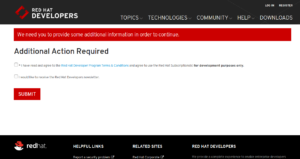A year ago Red Hat announced the availability of a no-cost Red Hat Enterprise Linux developer subscription available as part of the Red Hat Developer Program. Offered as a self-supported, development-only subscription, this developer subscriptions provides you with a stable development platform for building enterprise applications - across cloud, physical, virtual, and container-centric infrastructures.
Adoption has been excellent since then, but I was prompted (aka nudged, voluntold) to remind "non users" (yes, some of you are still out there) what it is and how to get it. But I'll also explain to "users" how to easily re-subscribe (it's still free) if your 12-month subscription is up. First, here's what you "non-users" can get if you become "users":
Red Hat Enterprise Linux development subscription summary:
The no-cost Red Hat Enterprise Linux Developer Subscription gets you:
- Red Hat Enterprise Linux Server - An application development entitlement to the world’s leading enterprise Linux platform. (This includes workstation components for desktop installation, too)
- Development tools with long-term support - Each major Red Hat Enterprise Linux release is supported for 10 years, so a broad set of included “base” development tools are also supported for that length of time; examples include GCC, Python, PHP, Ruby, Java, etc.
- Development tools with frequent updates - We also produce annual updates of important development components such as programming languages (GCC, Python, Node.js, Scala, etc.), open source databases (PostgreSQL, MongoDB, etc), web servers (Apache httpd, Nginx, etc.), and other development tools (Eclipse, Git, Maven, etc.); these are packaged via Red Hat Software Collections and Red Hat Developer Toolset and are part of this RHEL subscription. Most of these are also available as container images that can be run on RHEL or OpenShift Container Platform.
- Red Hat Container Development Kit (CDK) - CDK has seen great progress over the year and now CDK 3 beta is the simplest way ever to set up the CDK and install a local version of OpenShift or RHEL. Windows and MacOS users should look at the Red Hat Development Suite for an even smoother installation experience.
- Multiple RHEL versions. The default download is RHEL 7, but you can get RHEL 6 too! Very helpful especially if that's where your app is still at.
- Host or guest. If you want to install it as a guest on your local system, we have some handy "Hello World" instructions to walk you through it - for bare metal or a hypervisor on Windows, MacOS, or another Linux.
Usage terms?
TL;DR. Will you be using this for development purposes and not put apps into production? If you answer yes, then read on.
Go get it!
Download your no-cost RHEL Developer subscription today. It’s quite simple.
Renewing is a piece of cake
Many of you are starting to see that your 12-month subscription has ended, but renewal is very simple, still is n0-cost, and only requires that you agree to the then-current T&Cs. Login at developers.redhat.com, agree to the terms, and click submit. See the pic below - it really IS easy.

Marketing alert! If you want to stay informed of what's new, we recommend you receive the Red Hat Developer Program newsletter, too.
RHEL developer subscription FAQs
For more information, we've assembled the most common questions in this handy RHEL Developer Subscription FAQ document.
Last updated: November 1, 2023